

|
Home Updates Hydros Cars Engines Contacts Links Racing Contact On The Wire |
'Wilma' and not Fred Flintstone's wife
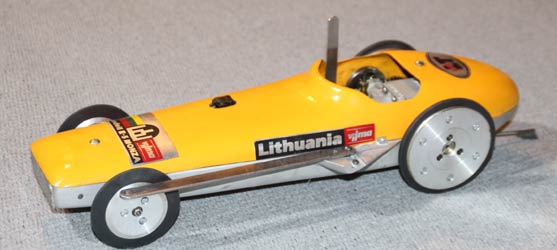
Usually, articles that appear on the website are the result of a great deal of research, fact finding and checking, plus a degree of luck along the way. Unusually, this one is almost the total opposite, yes, luck has played a part, but in the main, it is based on observations, recollections from a number of our contributors, suppositions, a deal of documentary evidence, google translations and artefacts that have turned up.
|
Here then is the somewhat unreliable background to what must be the most common, mass produced and importantly, ready to run, tethered car of modern times, the Wilma, or to be totally correct (possibly) the Vilma. In uncovering the background to this story though, it has to be said that there have been huge divergences of opinion surrounding the arrival and development of the 'alternative class' that still elicits heated discussions to this day. The Vilma Modell E5 Monza, to use its full title, has its origins way back in the 1950s with the Movosprint Ferrari, a European equivalent to the McCoy and other mite cars in the US. These were mass produced, ready to run, offering a cheaper and more simple alternative to an out and out race car. |
|
|
|
The Movosprint was available in two version, with a small motor for rail track racing where the motor was concealed under the bonnet to preserve the scale lines, or with a Super Tigre G20S occupying the cockpit. These provided an entry level to tethered car racing, a route taken by many, including some current competitors. Human nature being what it is, many cars did not stay in standard form for very long, indeed, Gustavo Clerici from Movo was happy to sell parts individually so that users could 'install their own ideas of what would go fastest'. At just under £16 before purchase tax or import duty it was not cheap, so never found a great deal of favour in the UK where the Oliver reigned supreme. |
|
In Italy and Switzerland the Movo proved very popular, being adopted as a class for beginners and Juniors and becoming the 'Monza Class' in competitions. Remarkably, the Movo Sprint car was still being run in competition into the 1980s along with the odd Oliver. As newer and more powerful ST motors were produced, so the original G20s were discarded, whilst a 1952 Ferrari was something of an anomaly as the class expanded, with a variety of home built cars using the latest Rossi and other motors. Thomas Finn claimed a world record at 161.074kph with a Movo but with not a lot left of the original, however, changes were afoot. Right: Record holding Movosprint |
|
A great deal of discussion and political wrangling ensued around 1980 over creating a new 'beginners class', based on freely available 3.5cc RC motors or continuing with a class of open wheel cars that allowed almost free rein development with the same sized motors. In Germany, Horst Denneler and Manfred Pfefferle produced a prototype for the 'beginners class' based on the Australian hot rod design, whereas in Switzerland, Christian Schmutz came up with a 'racier' design using a plate chassis, very similar to the 2.1s and 3.5s being run now. One model had internal front wheels and a motor mounted upright, RC style and the other a more conventional version with all wheels outside and the motor horizontal, intended for his son Michael. Interestingly, both models used silencers within the body shell, setting an important criteria for the new class. The four wheeled car called Michi is still in Michael's workshop forty years on.
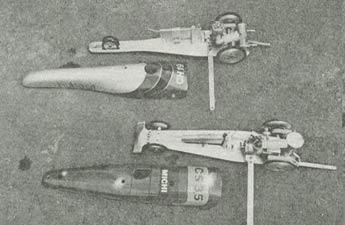 |
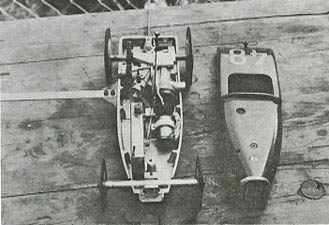 |
| Proposed Swiss cars | German proposal |
|
Ultimately, the concept of the beginners class was not accepted, allowing the open wheel 3.5cc class to continue in Europe as a separate entity. The USA and Australia already had national classes for 3.5cc cars with quite strict rules that constrained builders and WMCR had a 3.5cc class, so the class in Europe became E5, the name Monza eventually being consigned to the history books and Movo Sprint cars to collections. The rules for Class 5 set certain criteria that almost mirrored the second of Christian's designs, but up in Lithuania, a game changer was about to appear. Whether it is true or not, there is a suggestion
that Edvard Stelling was commissioned to create an entry level car for
the class.
He was already well established as an international racer and supplier
of tethered cars and engines under the Vilma name. |
|
|
|
Thanks to Raimondas Kochanauskas we now know that vilma is the name of the company and factory that produced the cars and components that bear this logo. The trademark/logo seen here and on tuned pipes and other components is a contraction of Vilnius Magnetephon a large company, primarily involved in producing tape recorders, both industrial and domestic. The anglicised version became Wilma, the name by which these cars are more commonly known. |
|
The Wilma car was based on a cast pan with a GRP top, a very lose representation of a full sized car, including an open cockpit. Front suspension was via independent trailing arms with rubber blocks. What set this car apart though was an interesting piece of lateral thinking that had probably not been considered when the rules were being drafted? The standard motor was a Russian MAC 3.5cc with a rear exhaust, but rather than have this plumbed into a silencer, Stelling cast a resonant chamber into the pan with a stinger screwed in at an angle behind the front wheels. |
|
|
Pristine, as it left the factory. Cars carried serial numbers in the pan, this one being 13 |
The chamber was covered with a machined plate and a small manifold connected the motor to this chamber. Apart from the compulsory knock off lever, the scale appearance of the car was maintained, even to the extent of having a stick-on decal for the front radiator grill.
|
|
Wheels were also scaleish with Dunlop balloon racing tyres, although modern Russian wheels with removable tyres front and rear were an option. For both the proposed Swiss car and the Wilma, the price for a complete car was 700DM, about £300 at the time, coincidence or a deliberate policy to keep the cost down? Stelling went one stage further though, producing a version with a scale body, mirrors, exhausts, fillers, proper grill and cockpit details with the larger Dunlop tyres all round. Left: Scale version owned by the late George Fausch |
|
Whether you are inclined to agree or not, to keep control of a basic or beginners class very strict rules and monitoring are required or it soon comes a free for all. Those that had built cars for the Monza class transferred their attention to the new class building cars that were within the rules, but far from the spirit of a junior or beginners class. The Wilma's initial advantage was soon its Achilles heel as the MAC is not the world's most powerful motor, so it was inevitable that it would become the first casualty, being replaced with Picco, Nova Rossi and even OS engines. Right: Standard car with 'aerodynamic' additions intended for a Norwegian junior |
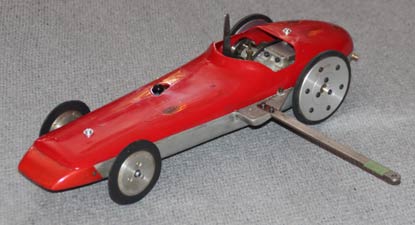 |
Coupling this range of engines up to the existing resonant chamber was not feasible, so anything from EFRA silencers to full tuned pipes were grafted on. It is not possible to get a decent bend on the exhaust and keep it within the bodywork so holes started appearing and then the bridle mounts had to be machined away to accommodate the manifolds.
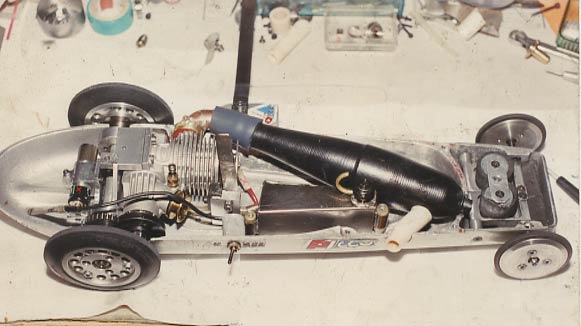 |
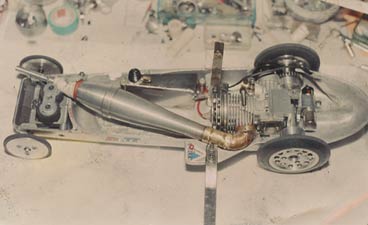 |
| Picco motor EFRA exhaust reversed front axles | Next mod, tuned pipe in Wilfrid Sott's car |
|
Next, extend the wheel base by turning the front suspension round or even have the suspension arms outside the car with a damper, extending them even further. To some extent, Stelling did recognise these changes, producing a new body with no cockpit and a much higher front. There was also a new pan casting that allowed a faux grill to be attached to the front, but still with the resonant chamber cast in. The final manifestation of the Wilma car was an entirely new pan casting, with no resonant chamber at all and the front suspension already turned round. Stelling was offering this version of the car with a Picco 4 port motor for 800DM in 2001. Right: Original pan, alternative body style, extended and damped front suspension. Werner Armend |
|
|
|
Eventually, the concept of the pan was abandoned by many, using either a plate or beam chassis with two piece GRP body shells to contain it all. Front suspensions became fully damped, leading link, extending well beyond the front of the car as the rules specified maximum overhangs for the bodies and wheelbase, but no minimums. This resulted in cars that differed considerably from the concept shown in the rule book, standard front induction motors also being superseded by more expensive, rear induction class 3 motors.
Some chose to continue to run Wilma cars, but they
were being overshadowed by these ever more complex and trick designs being
produced. The fate of the Wilma was finally sealed when the Class 5 became
eligible to collect FEMA points that counted towards a countries total score in
competitions. |
The class attracted champions from other classes intent on developing the concept, notably Mart Sepp, who overcame the problem of plumbing in a tuned pipe within the bodywork by having it stuck out the back of the car, producing a batch of these for sale.
This provoked a great deal of protest in 2000 as FEMA agreed that they had
missed the opportunity to create an 'easy class' for beginners and it
could be seen that within a couple of years someone would produce a full
race version capable of reaching 300kph. At the 2000 conference a
subsequent clarification of the rules required the pipe to be entirely
within the bodywork, with the exception of 10mm of stinger.
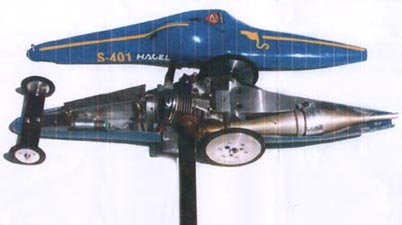 |
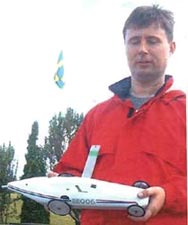 |
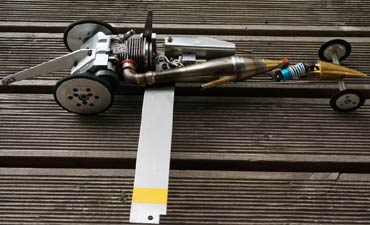 |
| Rolf Hagel's car with rearward facing pipe | Mart Sepp | Mart's record breaking car, new rules |
Ironically, this effectively banned all original Wilma cars as the stinger on these was 25mm. The establishment of the centerline of the car was clarified, although some seemingly ignored this with asymmetric wheel layouts that would be such a bone of contention years later. The clincher though was that those driving Class 5 cars could no longer run in any of the other classes, although this was later rescinded.
Further tweaking and changing of the rules allowed more extreme cars to come within the rules and finally, certain rules were either liberally interpreted, or ignored totally, marginalising the Wilma even further. In 2005 it was proposed to create a new class based on the 2.1cc EFRA motors but restricted to competitors between 10 and 25 years old. That, and a proposal to stop E5 cars scoring team points at the European Championships were both defeated at the delegates meeting.
To avoid confusion with the WMCR classes, Class E5 became 3b with the 5cc cars becoming E4 and the 10cc E5. Oddly enough, a 3b could run as a WMCR class 3 with just a change of bridle. The change from a wire tail skid to a skid integral with the body in 2013 caused problems as this was very difficult to achieve within the basic design of the Wilma style car.
|
More recently the decision was finally taken that 3b could no longer score points for nations and there has been a move to do away with the class entirely, although it does retain its popularity in some quarters with a significant entry at the last European Championships. FEMA discussed the matter at some length a while ago where it transpired that many of the older and established drivers liked the class but prospective newcomers thought they were old fashioned and did not represent what they wanted to run, so was the time now right to ditch the class entirely? Right: This car was for sale at Hannover in 2018, entirely original apart from the paint work, but with 'Monza 3.5' on the rear, a carry over from the origins of the class. |
|
There is no way of knowing just how many Wilma cars in the various versions were manufactured, but over the last couple of years a large number have turned up for sale, including four as new and seemingly un-run versions with the MAC motor, three of the scale versions as new and a number that have had modifications, varying from a small aerodynamic addition to everything altered within the car.
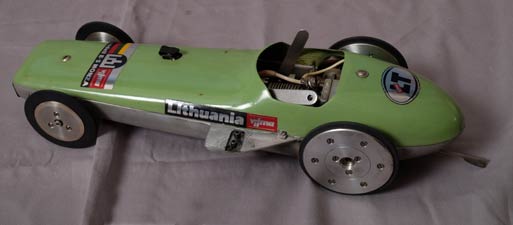 |
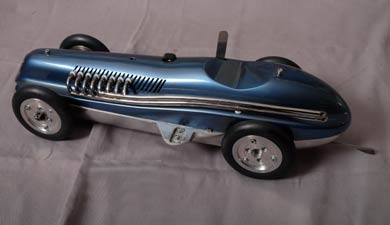 |
| Original car, still with decals intact | Scale version, twin exhausts on left |
Two cars have turned up in the US with body styles that have not been seen before, but both look original so just how many different pan castings and body styles were made remains something of a mystery?
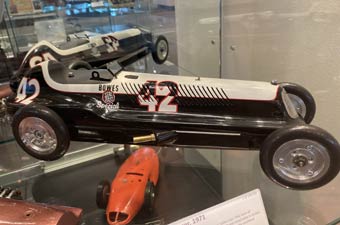 |
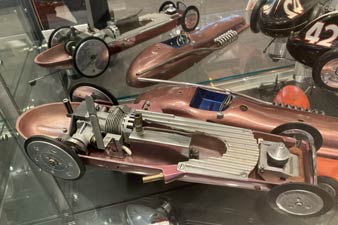 |
| Two examples in the American Museum of Speed in Nebraska | |
There are still forty one of these cars registered with FEMA, yet here the confusion still exists as nine are Wilma, two Vilma, seven Vilnius, nine Wilnius and fourteen as STL, Stelling's more usual car and engine identity. There are a few that have been run at Buckminster and a couple that have done duty in European races recently, but they are no match for the purpose built cars with Class 3 motors. The current price for a Wilma or similar type car seems about the same as they were new twenty plus years ago, but like the Movo, most will now be destined for the showcase (or Buckminster) but at a fraction of the cost of a Movo.
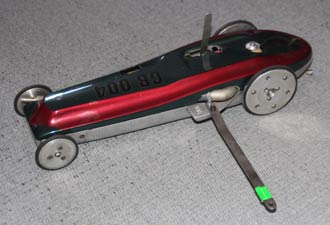 |
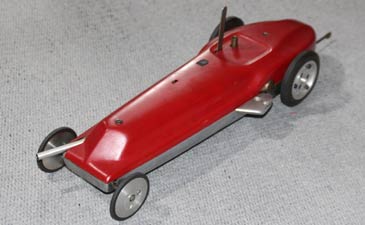 |
| Much modified by Wilfrid Sott Picco motor | Final version of the pan, OS motor |
Our thanks go to David Giles, who has provided much of the documentary evidence and context for the development and changes in the 3b Class. Christoph Zaugg has also provided important material, examples and recollections of the 'Movo days'. FEMA journals and many sessions with Google translate have provided the 'official view' and records whilst John Lorenz, along with John and Paul Goodall, David Giles, Oliver Monk and Stuart Robinson have provided even more examples of the Wilma and photos to illustrate this article, thanks to you all and to Raimondas Kochanauskas for the valuable update onm the origins of the name and the company behind the manufacture.
©copyrightOTW2023